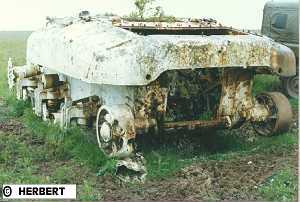 |
In
1985 David Herbert photographed the remains of a Ram Kangaroo near Warminster
at the Salisbury Plain Training Area in Great Britain. Just like many other
WW2 era AFVs, this Kangaroo was relegated to target duty after being struck
off charge in the 1950s. This was the fate of many WW2 AFVs, and even today
many can still be seen on ranges. They are rarely more than hardly recognisable,
severely damaged hulks, but this Ram Kangaroo was one of the few exceptions. |
| Like
most range targets it was regularly painted white or orange to improve
its visibility. I understand the object of artillery practise in the past
was to place the rounds close to the vehicle, rather than to hit them directly.
Apparently this was done to save targets (remember, this was long before
the CFE Treaty caused hundreds of AFVs to become available as targets).
Although the subject Kangaroo was hit a few times and had been damaged
by shrapnel, it had survived the rigours of its last posting. |
| It is
believed that at some point in time it was recovered from the range to
become part of a collection at the Warminster School of Infantry. In 1992
it was to be disposed of, at which time it was brought under my attention
by a regular contributor of the Sherman Register, Mr. Stephen Osfield.
It was secured by The Tank Museum at Bovington for the Canadian Defence
Liaison Section in London, which expressed an interest in a Ram Kangaroo
after seeing the restored one at Bovington. |
|
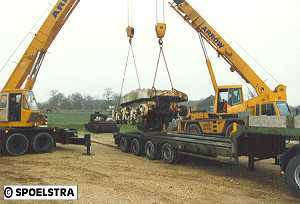 |
By
November 1992 the Bovington Tank Museum had recovered the Ram Kangaroo,
and David Herbert tipped me off when it was in the museum's workshop yard.
I then wrote the curator a letter to ask about the possibilities of making
the ex-Warminster Ram Kangaroo available for the memorial project at Mill.
Apparently the Canadian Defence Liaison Section changed its mind (maybe
because the Kangaroo needed more than 'a fresh coat of paint'?) and was
very happy for me to have the Ram Kangaroo for use in the proposed memorial
to the 1st Canadian Armoured Carrier Regiment. The curator agreed that
its was an ideal and fitting use for the AFV, so he raised no objections
and the title to the Ram Kangaroo was permanently transferred to the Sherman
Register. |
| The
photo shows the Kangaroo being loaded at Bovington on the 5th of February
1993. The Ram Kangaroo was transported to the premises of Scorpios at Beuningen,
the Netherlands. This company specialised in buying, selling, and restoring
WW2 era vehicles and accessories. Over the years, I had become acquainted
with the owners, father and son Schneider, and their band of regular volunteers
of which I had become one. The Schneiders were willing to help restoring
the Kangaroo and finance the project, in return for the M4A1 Sherman which
was at Mill at that time. This was a fair trade, and really the only way
I could realise this memorial project. |
|
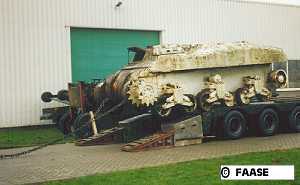 |
Unloading
the Kangaroo the next day later was easier than loading: we just winched
it off. Just before we started winching someone decided to place the Ward
La France M1A1 Wrecker just a little more forward - better to be safe than
sorry. But no one imagined that the Ram would roll that well! The twenty-ton
hulk also had no problem with crushing two hefty steel I-beams laid out
to stop it. Luckily, the Ram came to a halt just a meter or two behind
the wrecker. If we had not moved the wrecker forward it would have surely
been severely damaged by the rolling Ram. It was our first experience with
the entirely different class of vehicle we were now working with. Restoring
a tank starts with the special handling of a bigger and heavier object,
and then some... |
|
 |
First
thing to do was to fully assess what was needed to restore the Kangaroo
to static condition. We started by cleaning out the interior of the Ram.
The photo shows what it looked like after some bushes and almost half a
meter of mud had been cleaned out. Although the Ram Kangaroo hardly had
anything like an interior when new, being exposed to the elements for decades
certainly does not improve it. Many components such as the drive shaft
and battery boxes were missing, rusted away or removed by parts hunters
over the years. Still, the remains of the driver's seat base, his controls
and the gearbox can be seen up front. Most sheet metal was riddled by shrapnel,
though. The interior of the Ram was completely stripped, after which some
patches of severe rust (especially around the auxiliary machine-gun turret
ring) were removed with an air-operated needle hammer. |
| Neither
on this nor any of the other Ram Kangaroos have I seen any traces
of the benches that - according to some popular sources - were fitted
for the troops to be carried. When standing inside, you realise that there
is no room for benches of any sort if a full section of infantry was to
be carried. The Kangaroo purely served as a 'battle taxi', carrying infantry
from the starting line to their objectives. It cannot be compared with
today's APCs or even AIFVs. |
|
 |
A
similar shot taken as the Kangaroo was nearing completion. Note that the
interior has been stripped and heavily coated to prevent rusting and deterioration
over the years, destined as it is for outside display. Wire mesh was added
over the escape and special purpose hatches, to prevent entrance by small
(or larger...) children. The conical bracket on the left side of the turret
ring is the No.9 'B' set antenna base for the standard wireless set No.19
which was situated on the left-side sponson. The antenna in front is the
'A' set antenna, used for inter-vehicle communications. |
|
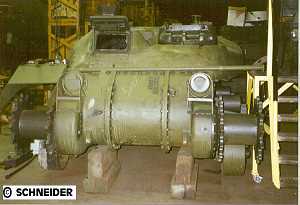 |
February
1995, two years after the Kangaroo arrived in Holland. Although all parts
- except for tracks - were finally there, we were becoming pressed for
time as we had a only some three months left before the Kangaroo would
have to be delivered at Mill. Therefore the Schneiders, helped by volunteers
Thomas Faase and Gerard Deibel, decided to spend a full week on the restoration
to finish most of the work. |
| This
front view shows the Kangaroo after it had been sand blasted, primered
and received its first coat of paint. At this stage the mudguards are being
fitted. They are bolted to tabs on the side of the hull and are supported
by the bar running across the front of the hull. The engineering drawings
for the front mudguards with integrated toolboxes were recreated by David
Herbert. Adrian Barrell made a good job of fabricating the mudguards and
some replica parts such as the headlights and their guards. At the rear
an ingenious construction was made in which replicas of the air cleaners
are incorporated with a panel to prevent entrance of the Kangaroo by small
children. |
|
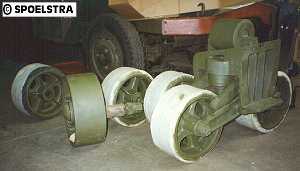 |
Two
years were spent collecting the parts needed. Although it seems the Kangaroo
was rather complete and was only to be cosmetically restored, this is not
a 2.5-ton GMC truck for which loads of NOS parts can be found on every
street corner. We needed all sorts of parts, ranging from small bits such
as headlights to larger items like engine decks, rear hull doors, a bogie
and mudguards. The hull structure itself was basically complete, except
for the bit above the rear hull doors, which had been cut away with the
doors while it was on the range. |
| With
help from David Herbert and others most parts could be found or replacements
made. We decided to use a mix of original and refabricated parts. This
was done with an eye to the third lease of life during which the Kangaroo
had to withstand the rigours of life as a plinth vehicle. Much more bearable
than range duty, but still with its demanding particulars. |
| The
photo shows some of the parts ready for fitting: a few road wheels, one
complete bogie (to replace one that had been completely destroyed by a
direct hit), and the repaired idler wheel (see the first photo). |
|
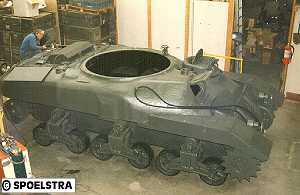 |
The
restoration is almost complete. Less than three months before the ceremony,
I still had to locate a set of tracks. I finally managed to secure a set
of T54E1 tracks, by bartering some old favours I had done a number of people.
I spent a day at a range to recover them, for which I was given the use
of a Leopard ARV with an experienced civilian crew and a chauffeured Mercedes
G-series. |
| Except
for the missing tracks and black interior, the photo shows what a typical
Kangaroo looked like. Note the armoured air intake cover, just behind the
turret ring aperture. This rare part was sourced by David Herbert. Not
much is known about it, but for the fact that is was used only on Ram Kangaroos.
If anyone knows more about it, please tell us. |
|
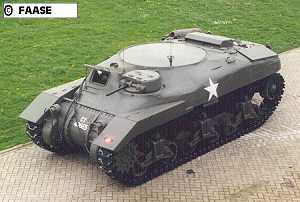 |
This
top view shows the finished Kangaroo. For safety reasons the Mill municipality
wanted the turret ring aperture closed over. Several options were reviewed
such as a glass plate and a wire mesh cover, but these all had insurmountable
drawbacks. It was decided to close the aperture with a bulged steel plate
that can withstand people standing on top. Of course the distinctive character
of the Ram Kangaroo is spoiled to some extent by this. It is a trade-off
between restoring this Kangaroo as a historically correct vehicle, making
it fit for service as a memorial out in the open and public safety. As
many of you will know from experience, military vehicles are an attraction
to many people and they invariably clamber all over them. The municipality
did not want to risk people's lives and limbs, and rightly so. Besides,
the cover is hardly noticeable when standing next to the Kangaroo. |
| Finishing
touches include a towing cable, replica .30 Browning barrel, aerials and
a tarpaulin (these last two items were fitted for the unveiling ceremony
only). |
| Because
there was relatively little known about the 1st Canadian Armoured Carrier
Regiment at the time we were restoring the Kangaroo, I had to make and
educated guess about its markings. Photos show many Kangaroos with the
white star (being the official Allied recognition marking) on their sides.
The left front mudguard sports the First Canadian Army formation sign,
because the Regiment was attached to the 25th Canadian Armoured Regiment
(for administrative purposes only) in October 1944. Only in December 1944,
two months after the Regiment's formation in Mill, it was attached to the
British 79th Armoured Division. Sadly neither the manufacturer's Shop Number
nor the War Department registration number could be traced back. Because
of various production features, this Kangaroo must have had a WD number
somewhere in the CT-40438 to CT-40937 range. As this Kangaroo has hull
casting serial number 665, it was decided to paint CT-40665 on the front
and rear of the hull. |
| Since
the restoration, we have learned that the 1st Canadian Armoured Carrier
Regiment had battle number 157 (in white on a green/blue rectangle) and
also that many Canadian vehicles often displayed a 'crooked' white star.
It is planned to rectify these details when the Kangaroo has to be repainted
in due time. |
|
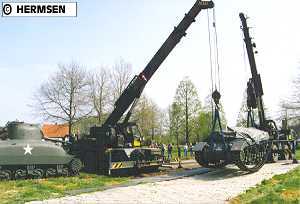 |
The
25th of April 1995: the Ram is being lifted in position by the Royal Dutch
Engineers. It took the place of the M4A1 Sherman that had been on this
concrete slab since being dragged from the local Army training grounds
in the 1970s. Notice the aluminium treadway laid out to protect the grass. |
|
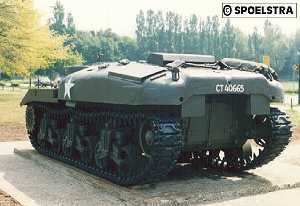 |
Rear
view of the Ram Kangaroo. Compare this photo with the first one - a lot
of hard work went into getting it in this condition, but every drop of
sweat was worth it. |
|
 13 Feb 00
13 Feb 00 |
History
of the 1st CACR (with more photos) |
|
Back to Restorations |
|
*NEW!*
|
The
Canadian Kangaroos Home Page |
|
| These images Copyright
© as per imprint, 1999 - All Rights Reserved. They may neither be
copied nor reproduced without written permission of their owners. |
|
| Page Copyright ©
Geoff
Winnington-Ball , 1999 - All Rights Reserved |










